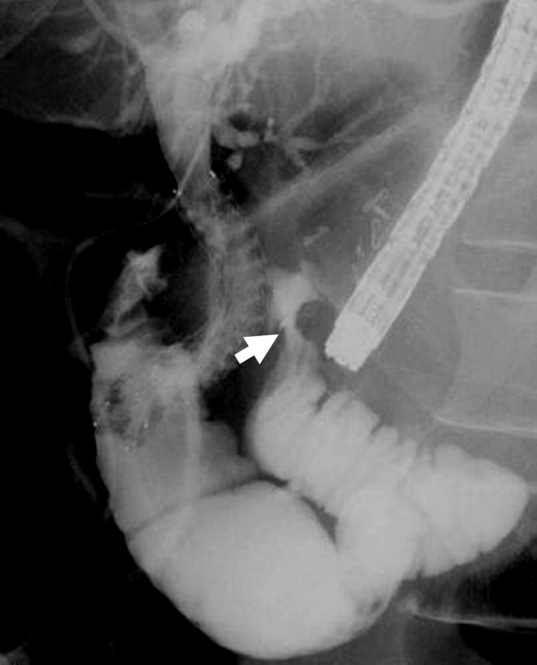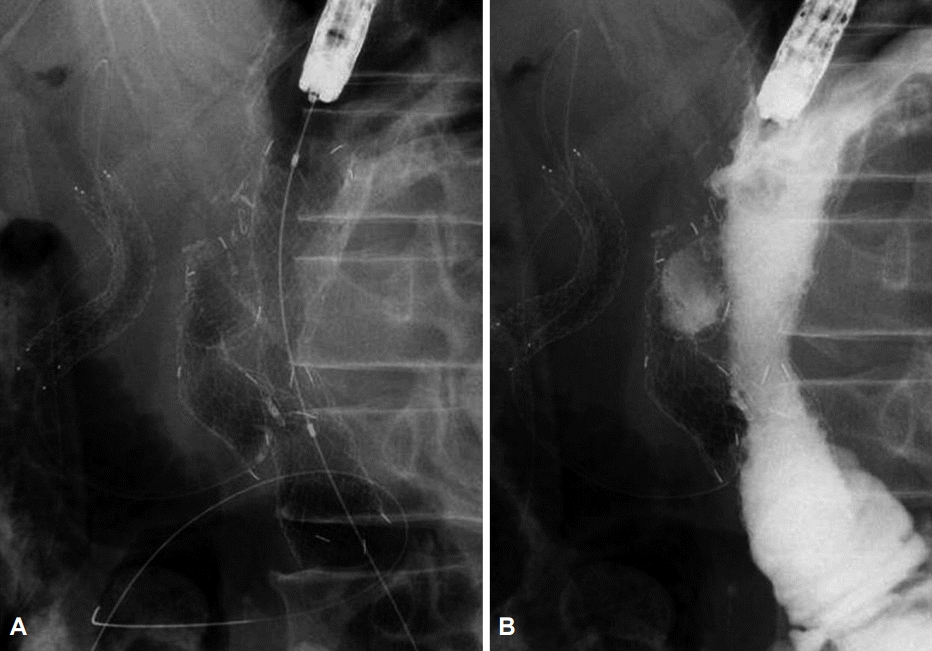Placement of endoscopic self-expandable metallic stents (SEMSs) is widely performed for malignant gastrointestinal obstructions as an effective palliative procedure [1-3]. However, because only one report exists on SEMS placement at the bifurcation of a surgically reconstructed intestine [4], the safety and efficacy of the procedure have not been elucidated. We present a case of double SEMS placement at the bifurcation in Billroth-II gastrojejunostomy.
A 75-year-old man who had undergone distal gastrectomy with Billroth-II reconstruction was admitted to our institution because of obstructive jaundice due to pancreatic head cancer. We performed percutaneous transhepatic biliary drainage (PTBD), and then a biliary metallic stent was placed percutaneously. Contrast medium injection to the afferent loop through the PTBD tube demonstrated an afferent loop stricture because of tumor invasion (Fig. 1). Therefore, we performed enteral metallic stenting with a rendezvous technique. A guidewire was passed through the stricture through the PTBD tube into the stomach. After an endoscope was inserted into the stomach, the guidewire was grasped and withdrawn through the channel, and an enteral stent (22 mmУ6 cm; Niti-S, TaeWoong Medical, Gimpo, Korea) was placed in the stricture (Fig. 2A). However, the expanded stent compressed the efferent loop, causing efferent loop obstruction. Contrast radiography showed that the contrast medium flowed only into the afferent loop (Fig. 2B). Therefore, a guidewire was passed through the stented side and into the efferent loop. Then, an enteral stent (22 mmУ10 cm; Niti-S) was placed from the efferent loop to the stomach (Fig. 3A). After efferent loop stenting, substantial contrast medium flow into the efferent loop was observed (Fig. 3B). Oral feeds were initiated a day after stent placement, and the patient was subsequently discharged. He died of primary cancer progression 5 months after stent placement, although there were no stent problems.
In recent years, malignant gastrointestinal obstruction of the esophagus, stomach, duodenum, and colon has been widely managed with endoscopic SEMS placement as an effective palliative treatment. However, because there are few studies on the use of metallic stents in the obstruction of a surgically reconstructed intestine, particularly stenting at the bifurcation of the surgically reconstructed intestine, the safety and efficacy of the procedure have not been elucidated. To the best of our knowledge, only one report exists on SEMS placement at the bifurcation of a surgically reconstructed intestine [4]. Kwong et al. [4] reported a case of concurrent afferent and efferent stents after a pancreaticoduodenectomy. Although their case eventually required three efferent limb stents for recurrent malignant obstruction along with an afferent limb stent, there were no serious complications.
In the present case, the expanded afferent stent compressed the efferent loop, causing efferent loop obstruction. Because an expanded stent may cause intestinal obstruction, endoscopists should be careful while performing enteral stenting at the bifurcation of a surgically reconstructed intestine. Especially, during afferent loop stenting, an additional efferent loop stent should be considered for the passage of food into the efferent loop.









